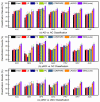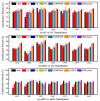Inherent Structure-Based Multiview Learning With Multitemplate Feature Representation for Alzheimer's Disease Diagnosis
- PMID: 26540666
- PMCID: PMC4851920
- DOI: 10.1109/TBME.2015.2496233
Inherent Structure-Based Multiview Learning With Multitemplate Feature Representation for Alzheimer's Disease Diagnosis
Abstract
Multitemplate-based brain morphometric pattern analysis using magnetic resonance imaging has been recently proposed for automatic diagnosis of Alzheimer's disease (AD) and its prodromal stage (i.e., mild cognitive impairment or MCI). In such methods, multiview morphological patterns generated from multiple templates are used as feature representation for brain images. However, existing multitemplate-based methods often simply assume that each class is represented by a specific type of data distribution (i.e., a single cluster), while in reality, the underlying data distribution is actually not preknown. In this paper, we propose an inherent structure-based multiview leaning method using multiple templates for AD/MCI classification. Specifically, we first extract multiview feature representations for subjects using multiple selected templates and then cluster subjects within a specific class into several subclasses (i.e., clusters) in each view space. Then, we encode those subclasses with unique codes by considering both their original class information and their own distribution information, followed by a multitask feature selection model. Finally, we learn an ensemble of view-specific support vector machine classifiers based on their, respectively, selected features in each view and fuse their results to draw the final decision. Experimental results on the Alzheimer's Disease Neuroimaging Initiative database demonstrate that our method achieves promising results for AD/MCI classification, compared to the state-of-the-art multitemplate-based methods.
Figures










References
-
- Association A. s. Alzheimer’s disease facts and figures. Alzheimers Dementia. 2013;9:208–245. 2013. - PubMed
-
- Fox N, Warrington E, Freeborough P, Hartikainen P, Kennedy A, Stevens J, Rossor MN. Presymptomatic hippocampal atrophy in Alzheimer’s disease A longitudinal MRI study. Brain. 1996;119:2001–2007. - PubMed
-
- Sled JG, Zijdenbos AP, Evans AC. A nonparametric method for automatic correction of intensity nonuniformity in MRI data. IEEE Trans Med Imaging. 1998;17:87–97. - PubMed
-
- Gaser C, Nenadic I, Buchsbaum BR, Hazlett EA, Buchsbaum MS. Deformation-based morphometry and its relation to conventional volumetry of brain lateral ventricles in MRI. NeuroImage. 2001;13:1140–1145. - PubMed
-
- Dickerson BC, Goncharova I, Sullivan M, Forchetti C, Wilson R, Bennett D, Beckett L, deToledo-Morrell L. MRI-derived entorhinal and hippocampal atrophy in incipient and very mild Alzheimer’s disease. Neurobiol Aging. 2001;22:747–754. - PubMed
Publication types
MeSH terms
Grants and funding
LinkOut - more resources
Full Text Sources
Other Literature Sources
Medical

